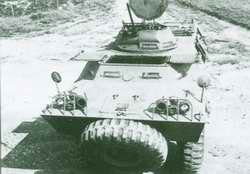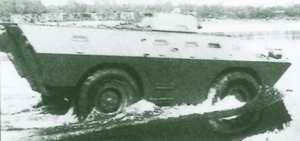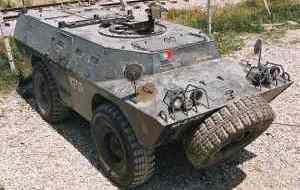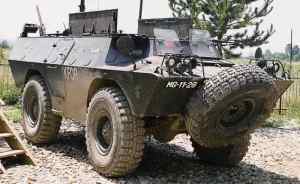| Designation: | Chaimite |
 |
|---|---|---|
| Manufacturer: | Bravia Sarl | |
| Product type: | Armoured Vehicles | |
| Name: | Reconnaissance Vehicle |
In the 1960s, a range of 4 × 4 armoured amphibious vehicles was developed by Joao Donas-Botto to meet the requirements of the Portuguese armed forces.
The first prototype was called the Chaimite (4 × 4) completed in 1963 and, by mid-2007, total production of this vehicle and its many variants amounted to about 600 vehicles.
The original Chaimite is now known as the Bravia Mk I (4 × 4) with production being undertaken by the now TRACE (Trading Company & Consulting Engineers) which is the holding company of the Bravia Group SA and Ordnance Engineering.
In addition to the Bravia Mk I (4 × 4) vehicles, 6 × 6 and 8 × 8 models have been developed, but these have not yet entered production. All these vehicles are fully amphibious, being propelled in the water by their wheels.
The basic APC is called the V-200. As far as is known, there has been no recent production of the Bravia series of armoured personnel carriers and reconnaissance vehicles in Portugal.
It is understood that the total of 92 for Portugal includes 15 used in the reconnaissance role and the remainder in the APC and specialised variant role. Following a competition, early in 2005 Portugal placed an order with Steyr-Daimler-Puch covering the supply of a total of 260 Pandur II (8 × 8) APCs and variants. Of these, 240 are for the army and 20 for the marines. These will replace remaining TRACE Bravia APCs and variants. First vehicles were delivered to Portugal in 2007. Description
(V-200)
The hull of the Bravia (4 × 4) APC is made of all laser-welded ballistic steel. The driver sits towards the front of the vehicle with the second crew member, normally the commander, to his right. Over their positions is a two-piece hatch cover that opens either side of the vehicle. The driver and commander each have a vision block to their front, between which is a single firing port. To the left of the driver and the right of the commander is a vision block and firing port.
There is a two-part door in each side of the hull, the upper part opening to the rear and the lower part folding downwards to form a step. There are two vision blocks and two firing ports in each side of the hull between the front of the vehicle and the side door.
The main armament is installed immediately behind the driver's and commander's position.
The power pack is at the rear of the vehicle on the left side and is separated from the personnel compartment by a fireproof bulkhead. Access to the power pack for maintenance is through two hatches in the roof and a single hatch in the left side of the hull. The power pack compartment is equipped with a fire extinguisher operated by the driver.
A door at the rear of the hull on the left side opens to the left and has a single vision block and a single firing port. There is an additional forward-opening hatch in the roof of the vehicle to the right of the power pack compartment and a firing port and vision block below it in the right side of the hull.
Power is transmitted from the engine to the transmission, then to the transfer case and finally to the front and rear axles. The axles are of the fully floating double-reduction type with locking differentials. The tyres are run-flat combat or bulletproof type.
Mounted in the front of the vehicle is a hydraulic winch with a maximum capacity of 4,530 kg, provided with 38.1 m of 11 mm diameter cable with a maximum breaking strength of 8,090 kg. Optional equipment includes passive night vision equipment and various weapon fits.
The Bravia is fully amphibious and propelled in the water by its wheels.
The V-200 is fitted with a Bravia-designed one-person turret armed with twin 7.62 mm (0.30) machine guns, twin 5.56 mm machine guns or one 7.62 mm (0.30) and one .50 (12.7 mm) machine gun. The weapons can be elevated manually from -15 to +50° and traverse is manual through a full 360°. The turret with twin 7.62 mm (0.30) machine guns is provided with 500 rounds of ready use ammunition (250 rounds per gun) plus a further 9,000 rounds carried in the vehicle in reserve. The turret has a single-piece hatch cover that opens to the rear, vision blocks and an M28C periscopic day sight mounted in the left side of the turret for aiming the machine guns. If required, the turret can be fitted with a device for launching five 60 mm anti-personnel, anti-tank, smoke, illuminating or incendiary grenades. The turret can also be fitted with four 3.5 in rocket launchers either side of the turret, which can be fired from inside the vehicle but are reloaded from outside.
A wide range of optional equipment can be fitted, including an air conditioning system, a fire extinguishing system and an explosion detection/suppression system. Variants
This model has a crew of four or five and can be fitted with a one- or two-man turret. The former is the Oerlikon Contraves GAD-AOA one-person turret armed with a 20 mm KAA-001 cannon. It should be noted that production of this turret was completed some time ago.
The following two-man turrets were marketed to be fitted to the V-300: Bravia turret armed with a 20 mm cannon (with 100 ready use rounds and 300 rounds in reserve), 7.62 mm coaxial machine gun (500 ready rounds), a 7.62 mm anti-aircraft machine gun (500 ready rounds) and 3,000 rounds of 7.62 mm ammunition in reserve. Various other single and twin 20 mm turrets were also offered for this vehicle, including twin 20 mm air defence turrets.
This could be fitted with a variety of two-man turrets currently marketed and armed with a 90 mm gun, 7.62 mm coaxial machine gun and 7.62 mm anti-aircraft machine gun.
This is a command and communications vehicle.
This is a mortar carrier with the 4 × 4 model being armed with an 81 mm/82 mm mortar, the 6 × 6 model with a 120 mm mortar and the 8 × 8 with a 160 mm mortar. It has not been confirmed that prototypes of the 6 × 6 and 8 × 8 versions of these vehicles were ever built.
ATGW vehicle armed with HOT, TOW or MILAN systems. It is understood that this never entered production or service.
This is the ambulance version and is unarmed.
Crash rescue vehicle. The 4 × 4 model has its own winch while the 6 × 6 and 8 × 8 models can also be fitted with a crane with a maximum lifting capacity of 5,000 kg.
This is a riot control vehicle and can be fitted with various armament installations including a water cannon.
Portugal fitted a number of its Bravia Mk I (4 × 4) vehicles with a single SS-11 wire-guided ATGW either side of the turret.
The all laser-welded ballistic steel hull of the Bravia Mk II (6 × 6) protects the crew from small arms fire and shell splinters.
The driver is seated at the front of the hull on the left side and has a single-piece hatch cover that opens to the rear. In front of this hatch cover are three day periscopes, the centre one of which can be replaced by a passive night vision periscope.
The V-8 turbocharged diesel engine is to the right of the driver with the air inlet and air outlet on the right side of the hull.
The main armament for the APC version, the V-200, is installed in the centre of the hull. The troop compartment is at the rear and the troops enter and leave the vehicle via two doors in the rear of the hull that open outwards.
There are two hatches over the roof compartment, which open outwards and in each side of the hull are four vision blocks each with an associated gun port. Each of the rear doors also has a vision block and associated gun port.
Each axle is provided with locking differentials and hydraulic shock-absorbers. Tyres are of the run-flat combat or bulletproof type and are 11.00 × 20.
This is generally similar to the Bravia Mk II (6 × 6) model described previously except that while this model has front axles with coil springs and rear two axles have torsion bars, in the case of the Mk III (8 × 8) the first two axles have coil springs and last two have torsion bars.
|
||||||||
|
||||||||||||||||||||||||
 |
 |
 |
 |




